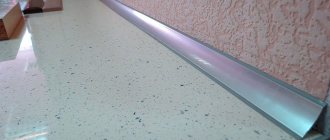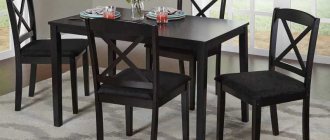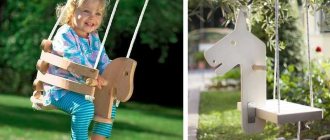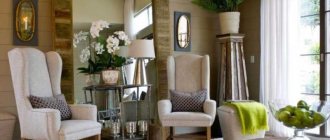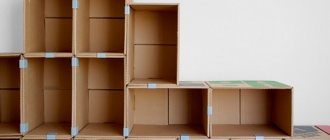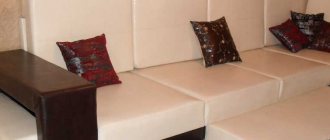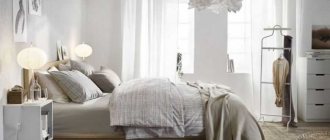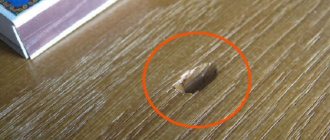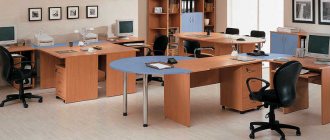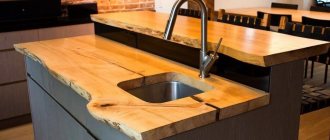Chipboard and MDF boards
Today this is the most popular and accessible material. It is a regular sheet of chipboard covered with a layer of plastic and lamination. Thanks to this, it has high performance characteristics, and the manufacturing technology allows you to paint the surface in any color and apply designs to it.
And yet there are also disadvantages. This material is not resistant to aquatic environments. Gradually, saturated with moisture through micropores, the tabletop swells and loses its appearance. There is only one way out - replacement. Sharp and strong impacts and caustic dyes can also lead to this problem. Therefore, be more careful about your headset. And one more little tip. Look for a multi-colored or textured print. On it, minor flaws will be almost invisible, unlike a plain one.
Impenetrable steel
This is a fairly rare material for use at home; it is usually used in professional kitchens. And for good reason – a steel countertop is characterized by increased wear resistance and ease of cleaning. Its production is quite labor-intensive: laminated chipboard sheets are sheathed with thin layers of stainless steel and the edges are processed. You won’t find it in mass production, but for individual assembly, please.
This surface is available in both mirror and matte versions; the second, by the way, is more practical. Scratches and dirt are not so visible on it. You can also find embossed material. But the mirror countertop will have to be polished often. By the way, although steel is a durable material, it still cannot withstand sharp targeted impacts.
How to make a computer desk at home
Ergonomics, quality of material, reliability of fittings – requirements are imposed on any furniture based on its purpose. The work area always involves increased load and quite a lot of wear and tear. Therefore, when creating a sketch, you need to consider how the parts will be attached, how strong the table will be, and so on.
Tabletop fastenings may vary
Sketch development
A sketch is needed to fully determine the assembly order, quantity and types of base material for the countertop, design and configuration.
Procedure for developing a diagram:
- first determine the style - it is important that the size and shape of the tabletop fit into the interior and dimensions of the room;
- Next, the color, material, and other individual characteristics of the model are determined;
- If you have no experience, you can use a ready-made drawing, or take a diagram from design programs as a basis. The advantage of ready-made packages is the accuracy of calculations (dimensions, markings for the frame, fittings and other important assembly components).
Prepare a sketch of the tabletop
If the tabletop is connected to a special niche in which excess wires will be hidden, you will have to think about through holes in advance. They will help maintain order in the workplace.
The simplest PC desk should match the decor of your living space
Dimensions
When making calculations, you need to pay attention to the length and width of the tabletop.
The length should not be too short or too long, and in general it is recommended to follow the rules:
- The space for the owner should be approximately 60-70 cm.
- The rotating part of the tabletop is approximately 55-60 cm.
The average size of corner computer tabletops is 160-170 centimeters; for a compact PC placement, 130 cm is sufficient. The straight model goes well with a length of 100 cm or more.
Additional details affect the dimensions
The depth of the countertop is determined by a fairly simple method:
- The worktop without extensions must be constructed with a minimum depth of 45 cm.
- If there are extensions, the depth of the tabletop should be from 60 to 70 cm.
- Tabletops in designs with drawers have a depth of at least 65 cm.
- For corner countertops with lower shelves, the depth is calculated to be at least 85 cm.
Standard dimensions of a straight tabletop
What you will need
Before you go to buy a tool, you need to decide on the base material - this determines how much and what quality it will be needed. If we talk about the basic set for work, it includes:
- Tape measure, square, ruler for measurements.
- Pliers.
- Hammer.
- Awl.
- Screwdriver.
If you plan to make a countertop from laminated chipboard or LMDF sheets, the following tools will be useful:
- Iron for joining edges.
- Drill bit for installing door hinges.
- Screwdriver (using nails and a hammer is not always possible, but screws form a stronger and more reliable structure).
Tools for creating a tabletop - varied
Prices for popular models of screwdrivers
Screwdrivers
A metal tabletop frame requires:
- Bulgarians.
- Electric drills.
- File.
- Sandpaper.
Additionally, materials may be required that will give the final product an original look.
The final appearance of the table can be supplemented during the assembly stage
General operating procedure
You can imagine assembling a tabletop as a sequence of actions:
- production of table components;
- preparatory work – processing of parts;
- combining structural elements.
A table made of laminated chipboard is quite rigid in itself and does not require a frame. To make a tabletop, you need to do the following:
- cut slab parts according to specifications;
- process the edges of the resulting parts, for which they use thin materials on which an adhesive layer is pre-applied, or thick ones with a special edge;
- Various methods are used to assemble parts - confirmat, ties, screws, corners, etc.
Material processing
Prices for the popular range of circular saws
A circular saw
If the countertop structure contains metal elements, welding work may be required in a prepared room or outdoors. If you don't have a welding machine at hand, you can use bolts. It should be remembered that in this case the connection will not be as neat and compact as with welding seams. An exception is the use of chrome-plated tubes, when the assembly is initially carried out using bolts and connecting elements.
Working with metal is complicated by the presence of welding joints
Working with solid wood to produce a solid table requires special equipment and manipulation of machines located in specialized workshops. Wooden parts are processed with a lot of dust and debris, so it is better to carry out final finishing and assembly at home, entrusting the preliminary work to professionals.
Choosing a place for the table
A desk that is too large will make it difficult to move around the room, while a desk that is too small may not be functional enough for everyday tasks. Therefore, when designing a tabletop, this point should be taken into account.
The following requirements must be met:
- presence of a grounded socket;
- the absence of heating devices near the table - batteries, fireplaces, electric heaters, so that the computer does not become unusable due to unacceptable temperature conditions of operation;
- decorative elements, shelves and pictures should be removed so as not to interfere with the placement of additional elements above the tabletop.
Simple corner table
The simplest corner option will not require the future owner to have any special design skills or work with various materials.
Stage 1. In order to construct a simple corner tabletop, the materials you will need are:
- standard chipboard or laminated chipboard, as well as laminate – 1 piece;
- about 2.5 m. C-shaped edging (PVC profile);
- fastener
Drawing for cutting and fastening the tabletop
The T-shaped edge can only be taken if a special tool will be used for the work.
To mark the parts of the table you will need chalk or a marker. They can also be useful during assembly. The ideal option for work is washable markers.
Stage 2.
After cutting the base material, the table is assembled.
We fix the tabletop with corners to the wall
Schemes for fastening the corner part
The advantage of this method is the rational use of raw materials. The trimmings will close the gap in the corner, and will also become the basis for shelves - for a printing device (1st) and a speaker system (2nd). A general idea of the assembly can be seen in the photo. The fasteners in the green circles are self-tapping screws that are screwed into the slots using washers. The red part refers to the support for the far corner of the tabletop. In this case, the self-tapping screw is located obliquely and upward in the wall.
The cuts in the process of working with the material may be sloppy - in this case, they are either covered with a finishing edging, or left in their original form, when this is acceptable from an aesthetic point of view.
Despite the simplicity of the design, a computer tabletop made according to these instructions can withstand up to 80 kg. weight. An additional advantage of the table is its compactness and ability to take up minimal space in the room. If a system unit is supposed to be placed under the table, you need to equip furniture corners for it. To prevent it from tipping over, you can add a stopper made from a piece of plastic box to the structure.
The finished structure can be supplemented with shelves
A corner shelf in a room is an excellent solution that will not allow a single centimeter of free space to go unused. Find instructions for making shelves in a special article.
Video - DIY computer desk
Video - Do-it-yourself table or purchased one?
Video - Do-it-yourself computer desk from chipboard scraps
Wood
This is the most noble and capricious material. It can fit perfectly into any, even ultra-modern interior. But for such luxury you have to pay not only a significant sum, but also daily polishing and weekly application of special protective wax.
It is also worth remembering the following restrictions: you cannot place hot dishes on it, you must not wash it with caustic substances and under no circumstances allow contact with coloring elements. But if any of the troubles happen, you can simply remove the tabletop and send it for restoration.
But if you want your kitchen to be decorated with a wooden countertop, then it is best to choose Russian larch. This type of wood is ideal for use in the kitchen. It does not rot from high humidity and is practically not susceptible to mechanical shock. At the same time, the cost of larch is lower than other tree species.
Methods for restoring table surfaces
Some of you who want to restore a table have probably wondered how the whole process works and what is needed for this. Many people mistakenly believe that a lot of money is needed to restore the attractiveness of a particular thing. This is wrong!
Direct proof of this is the inexpensive methods of restoring table surfaces, which you can learn about right now:
- Painting using old, unnecessary tulle. To decorate an old table with an interesting pattern, just arm yourself with tulle and spray paint of the desired color. Then you need to lay the fabric over the horizontal surface of the table so that the pattern is correctly positioned. Then paint over everything with paint and wait until it dries completely. Remove the fabric and discard it as it is no longer suitable for use. Unless you decide to make the same pattern on old chairs or a cabinet.
- Ceramic tiles can also be a great way to restore an old favorite table. The big advantage of this material is its practicality and durability. The tile will be able to withstand many years of loads and various types of impacts on its surface. You can purchase both large pieces of ceramics and small fragments, which are very popular today (mosaics). In the absence of the opportunity to spend money on such purchases, the old surface of the desktop can be decorated with fragments of broken bottles of different colors.
- Self-adhesive film is one of the most budget-friendly ways to restore old furniture. Its price will allow everyone to feel like a designer and make a cute piece of furniture even from a shabby table.
- If you have some knowledge in the field of burning techniques, then you have every chance of making a real work of art from a wooden surface. In this case, you cannot do without a special device - an electric burner.
- No less popular and accessible is the method of restoring old interior items using the decoupage technique. Using old newspapers or magazines will turn the wooden surface of the table and the product as a whole into a stylish and unusual element of your home.
Fake diamond
Another name for this material is acrylic stone, or Corian. It is very pleasant to look at and is versatile. Corian manufacturing technology allows you to create a cast - or at least without a rough seam - working surface. From a wide range of colors and textures you can create a unique design for any furniture or architectural form.
This wonderful material was created in laboratory conditions in the 60s of the last century, and in the 90s many related materials appeared, such as axilan, varicor and others. Thanks to their smooth surface, they are not susceptible to the harmful effects of moisture and fungus. Artificial stone can withstand impacts well, but is very sensitive to scratches and hot objects. Another significant advantage is easy restoration by an experienced craftsman.
When choosing the right size, it is recommended to follow these rules:
1. When calculating the overall dimensions of the tabletop covering, you should take into account installation tolerances and gaps that inevitably appear during the installation process. It is advisable to take a table cloth with a margin of 5-10 cm in length. It’s never too late to cut off extra centimeters, but to add them without getting a visible joint is problematic.
2. If the kitchen design involves a complex geometric shape, or a separate arrangement of furniture elements, it is more economical to buy larger countertops, and then cut them to the required dimensions. In this case, less scraps remain during installation, the cut pieces are easier to assemble, and besides, one 4-meter tabletop costs less than two two-meter ones.
3. The standard depth of the table cover is 60cm. It is calculated based on the depth of the base cabinet, the space behind the cabinet and the front overhang, but if the design solution involves combining the window sill and work surface in one plane, the standard solution is not suitable. You should choose a tabletop with a depth of 120cm. In such a canvas, appropriate cutouts are made for window bevels, and it is installed end-to-end in the place provided for by the project.
4. For most types of materials, the thickness (height) of the countertop is directly dependent on its price. The thicker, the more expensive. However, a thin countertop is not suitable for areas where a sink or built-in kitchen appliances need to be embedded. In this case, saving is not recommended.
5. When purchasing a countertop for floor cabinets, do not forget about the table for eating. Made in the same style, the kitchen and table top form an ensemble that harmoniously fits into the overall design concept. In this case, you can order the surface for the dining table as a separate piece, or use the remnants of the kitchen work surface.
6. Coatings made from natural materials (natural stone) have their own specifics, including dimensions. A linear meter of such products is not cheap. As a rule, manufacturers and sellers offer their products to order, in sizes adapted to a specific kitchen model. In addition, working with such surfaces requires experience and certain skills.
7. To avoid the headache associated with calculating the required dimensions of the tabletop, you can always use the services of professional measurers and installers. Experienced craftsmen will give advice, help with the choice, and correct possible nuances during installation.
Return to list
Quartz stone
Agglomerate is a transitional link from artificial stone to natural stone. Up to 90 percent of crushed quartz stone is added to its composition, thanks to which this material is very similar to natural stone to the touch and visually. But it is more resistant to the harmful effects of ultraviolet radiation, hot surfaces and impacts.
However, if damaged, restoring or repairing such a countertop is almost impossible. And you can forget about the continuous surface of agglomerate. Today, a seamless surface can be no more than 3 m long, and the shape should be close to rectangular.
Table restoration
Each of us at least sometimes thought about creating with our own hands something unusual, original and something that could stay with us for many, many years. So, an ideal option for creativity could be a table surface that has already slightly lost its diligent appearance and is just asking for help.
Methods of restoring furniture today are simple and accessible to everyone. By doing it yourself, you will receive an exclusive item that has no analogues in the whole world.
Natural stone
To create a truly luxurious and aristocratic kitchen interior, this material is best suited. Not only unsurpassed aesthetic qualities, but also an indecently high price confirm the elite status of countertops made of natural stone. The more common materials are basalt and granite; traventine and marble are much less common.
The stone, despite its solid reputation, is very capricious and does not have the lowest performance indicators. Therefore, it must be covered with protective solutions. Contact of such a surface with caustic and coloring substances is extremely contraindicated. They, like chips, cannot be restored. And one more important point is the large weight of the tabletop, which should be taken into account when designing the set.
Strained glass
Quite a rare and expensive material in our country, but very effective. Its surface can be either smooth or textured, glossy or matte, plain, colored or with an unusual print. Glass does not deteriorate from exposure to moisture, heat and fungus. It is very easy and pleasant to care for. But the fragile nature makes itself felt, so scratches and mechanical shocks are detrimental to such a tabletop - they are not masked or restored.
Ceramics
Tile is a wonderful material for decorating a countertop, which will help create an unsurpassed rustic interior or a romantic Provencal style. The main thing is that the selected tile is processed and can withstand mechanical shocks.
It is so light that it can provide an invaluable opportunity to independently design and manufacture a kitchen from available materials, such as laminated chipboard or furniture plywood. But the money saved will go towards paying the tilers, whose work is highly valued.
Concrete
Quite a popular material from European branded kitchen furniture manufacturers. But not only professional studios take on the production of such countertops - many craftsmen with certain skills can easily create newfangled work surfaces.
The best part is that you can do anything with concrete: add color at the pouring stage, paint, sand, pour textured models, and even dilute cold cement stone with colored glass and other decorative trinkets.
It is impossible not to note its high performance characteristics, which are expressed in excellent resistance to high temperatures, constant exposure to moisture, shock, scratches and caustic liquids. However, concrete can easily absorb dyes, so treatment with protective solutions is mandatory. Another difficulty is the installation of a massive countertop, which requires certain professional skills.
Knowing the characteristics of each material, you can easily choose the one that is best suited for creating a work surface. The main thing is to objectively assess your capabilities, priorities and attitude towards the ritual of cooking.
Chipboard: production, characteristics and advantages
Chipboard is a material made from natural raw materials, shavings and sawdust, which are impregnated with resins. The most important factor in the popularity of the material was its low cost, availability and versatility - it is used in the manufacture of furniture, partitions and other interior elements.
The choice of material for a kitchen countertop is often opted for chipboard, precisely due to the combination of a budget price and decent technical features. It is worth paying attention to an important characteristic of particle boards: formaldehyde resins are used as a binding material. Formaldehyde is known for releasing toxic components, but chipboard manufacturers have taken care of this - only class “E1” boards are used for furniture, boards that are safe for humans. Strict standards for the production of chipboards have been developed that relate specifically to this characteristic of the boards - at the moment, all domestic companies follow strict standards.
A comparison of countertop materials allows us to highlight the following features and advantages of chipboard:
- The use of special impregnation makes it possible to ensure a sufficiently high level of surface resistance to moisture - this is achieved by using a paraffin emulsion.
- Used for the production of countertops, class “B” chipboards are characterized by high strength.
- Chipboard is easy to process - drilling, sawing.
- Aesthetics: Various finishes are available, including bright colors, imitation of natural stone and wood textures.
- Weight: Chipboard is characterized by its low weight, which simplifies the installation and delivery process.
- The surface is protected from the negative, destructive effects of acids, chemicals, high temperatures, and UV radiation.
Of all types of kitchen countertop materials, coated chipboard is called the budget version of solid wood - in terms of technical features and surface aesthetics, modern manufacturers have achieved excellent results. Thickness options are available to order: 26 and 38 mm.
Chipboard acts as a base, and the finishing is made from the following materials:
- Melamine: an inexpensive, simple option, it involves the use of special kraft paper impregnated with melamine resin. A wide variety of textures, colors and patterns, sufficient resistance to moisture. The option is not the most durable.
- Veneer: natural veneer is beautiful and stylish, fits harmoniously into classic and modern interior styles. To protect against moisture, a layer of varnish is applied. There are no comments on the aesthetic qualities of veneer - it realistically imitates natural wood, but it should be protected from damage, scratches, and chemicals.
- Steel: stainless steel is sometimes used as a finish for chipboard - this is a rare case, but it is stylish, practical, and fits perfectly into a high-tech, futuristic interior.
The last, most popular and practical type of coating is lamination using HPL plastic.
